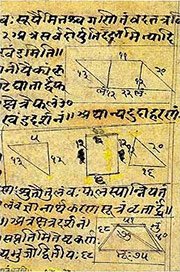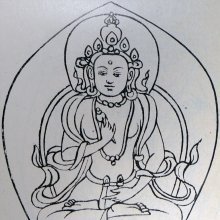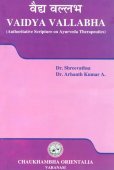Hastin, Hastī, Hasti: 34 definitions
Introduction:
Hastin means something in Buddhism, Pali, Hinduism, Sanskrit, Jainism, Prakrit, the history of ancient India, Marathi, Hindi, Tamil. If you want to know the exact meaning, history, etymology or English translation of this term then check out the descriptions on this page. Add your comment or reference to a book if you want to contribute to this summary article.
Images (photo gallery)
In Hinduism
Purana and Itihasa (epic history)
Source: Wisdom Library: Bhagavata PuranaHastī (हस्ती):—Son of Bṛhatkṣatra (one of the five sons of Manyu, who was the son of Vitatha (another name for Bharadvāja)). He established the city of Hastināpura (New Delhi). He had three sons, named Ajamīḍha, Dvimīḍha and Purumīḍha. (see Bhāgavata Purāṇa 9.21.1, 9.21.19-20)
Source: Google Books: Cultural History from the Vāyu PurānaHastin (हस्तिन्) falls under the category of wild beasts (āraṇya-paśu) according to the Vāyu Purāṇa.
Source: archive.org: Puranic Encyclopedia1) Hasti (हस्ति).—A King born in the lunar dynasty. (Ādi Parva, Chapter 94 Verse 58).
2) Hasti (हस्ति).—Another king of the lunar dynasty. His father was Suhotra and mother Suvarṇā, who belonged to the Ikṣvāku dynasty. This Hasti married Yaśodharā, daughter of King Trigarta, and a son called Vikaṇṭha was born to them. Hastināpura was the city newly built by Hasti. (Ādi Parva Chapter 95, Verse 34).
Source: Cologne Digital Sanskrit Dictionaries: The Purana IndexHasti (हस्ति).—Is Nāga; a line of Krodhāvaśa.*
- * Brahmāṇḍa-purāṇa III. 7. 349; 8. 70.
1a) Hastin (हस्तिन्).—A son of Bṛhadkṣatra, (Suhotra, Vāyu-purāṇa). After him came Hastināpura.1 Father of Ajāmīḍha and two other sons.2
- 1) Bhāgavata-purāṇa IX. 21. 20-21; Vāyu-purāṇa 99. 165; Viṣṇu-purāṇa IV. 19. 28; Matsya-purāṇa 49. 42.
- 2) Viṣṇu-purāṇa IV. 19. 29.
1b) A son of Vasiṣṭha and a Prajāpati of the Svārociṣa epoch.*
- * Matsya-purāṇa 9. 9.
Hastī (हस्ती) is a name mentioned in the Mahābhārata (cf. I.89.51) and represents one of the many proper names used for people and places. Note: The Mahābhārata (mentioning Hastī) is a Sanskrit epic poem consisting of 100,000 ślokas (metrical verses) and is over 2000 years old.

The Purana (पुराण, purāṇas) refers to Sanskrit literature preserving ancient India’s vast cultural history, including historical legends, religious ceremonies, various arts and sciences. The eighteen mahapuranas total over 400,000 shlokas (metrical couplets) and date to at least several centuries BCE.
Natyashastra (theatrics and dramaturgy)
Source: archive.org: Natya ShastraHastin (हस्तिन्).—Description of a women of elephant (hastin) type;—A woman who has a large chin and forehead, is fleshy and bulky, has tawny eyes, hairy body, is fond of sweet scent, garlands and wine, has an irascible temper, steady energy, loves water, garden, forests, sweet things and sexual intercourse, is said to have the nature of an elephant (hastin).

Natyashastra (नाट्यशास्त्र, nāṭyaśāstra) refers to both the ancient Indian tradition (shastra) of performing arts, (natya—theatrics, drama, dance, music), as well as the name of a Sanskrit work dealing with these subjects. It also teaches the rules for composing Dramatic plays (nataka), construction and performance of Theater, and Poetic works (kavya).
Ayurveda (science of life)
Source: archive.org: Vagbhata’s Ashtanga Hridaya Samhita (first 5 chapters)Hastin (हस्तिन्) [=Hastinī?] or Hastinikṣīra refers to “milk coming from the elephant”, as mentioned in verse 5.27-28 of the Aṣṭāṅgahṛdayasaṃhitā (Sūtrasthāna) by Vāgbhaṭa.—Accordingly, “[...] among the (different kinds of milk [viz., payas]), [...] (the milk) of a cow-elephant [viz., hastin] (is) strongly generative of firmness”.
Note: hastinyāḥ—“of a cow-elephant [hastin]”, to which kṣīra “milk” must be supplied from the context, has been made the agent in Tibetan (lit. “by a cow-elephant one is made very firm”), ban-glaṅ-mo-yis being of course a metonymy for ban-glaṅ-moi o-mas.

Āyurveda (आयुर्वेद, ayurveda) is a branch of Indian science dealing with medicine, herbalism, taxology, anatomy, surgery, alchemy and related topics. Traditional practice of Āyurveda in ancient India dates back to at least the first millenium BC. Literature is commonly written in Sanskrit using various poetic metres.
Jyotisha (astronomy and astrology)
Source: Wisdom Library: Brihat Samhita by VarahamihiraHastin (हस्तिन्) refers to “elephants”, according to the Bṛhatsaṃhitā (chapter 2), an encyclopedic Sanskrit work written by Varāhamihira mainly focusing on the science of ancient Indian astronomy astronomy (Jyotiṣa).—Accordingly, “We shall now proceed to give a brief description of (the qualifications of) a jyotiṣaka. [...] In Yātrā, he must know the fitness or unfitness of a tithi (lunar day), vāra (week day), karaṇa, nakṣatra, muhūrta, and lagna (a sign of zodiac) and yoga for particular purposes. He must be able to interpret natural gestures and dreams; he must be able to state when a prince ought to start for battle to secure success in war; he must be learned in rules relating to ablutions and sacred fire ceremonies in honour of the planets and offerings to evil spirits; he must be able to interpret phenomena connected with such sacred fires and with elephants and horses [i.e., hastin-aśva-iṅgita] while mounting the same”.

Jyotisha (ज्योतिष, jyotiṣa or jyotish) refers to ‘astronomy’ or “Vedic astrology” and represents the fifth of the six Vedangas (additional sciences to be studied along with the Vedas). Jyotisha concerns itself with the study and prediction of the movements of celestial bodies, in order to calculate the auspicious time for rituals and ceremonies.
Ganitashastra (Mathematics and Algebra)
Source: archive.org: Hindu MathematicsHastin (हस्तिन्) represents the number 8 (eight) in the “word-numeral system” (bhūtasaṃkhyā), which was used in Sanskrit texts dealing with astronomy, mathematics, metrics, as well as in the dates of inscriptions and manuscripts in ancient Indian literature.—A system of expressing numbers by means of words arranged as in the place-value notation was developed and perfected in India in the early centuries of the Christian era. In this system the numerals [e.g., 8—hastin] are expressed by names of things, beings or concepts, which, naturally or in accordance with the teaching of the Śāstras, connote numbers.

Ganitashastra (शिल्पशास्त्र, gaṇitaśāstra) refers to the ancient Indian science of mathematics, algebra, number theory, arithmetic, etc. Closely allied with astronomy, both were commonly taught and studied in universities, even since the 1st millennium BCE. Ganita-shastra also includes ritualistic math-books such as the Shulba-sutras.
Yoga (school of philosophy)
Source: ORA: Amanaska (king of all yogas): A Critical Edition and Annotated Translation by Jason BirchHastī (हस्ती) refers to an “elephant”, according to the Amanaska Yoga treatise dealing with meditation, absorption, yogic powers and liberation.—Accordingly, as Īśvara says to Vāmadeva: “[...] Wherever the mind goes, it is not to be prevented [going] from there. Unobstructed, it comes to an end. However, being impeded, it increases. Just as an elephant (hastī) without a goad, having obtained [his] desires, stops [wandering], so the mind, unobstructed, dissolves by itself. [...]”.

Yoga is originally considered a branch of Hindu philosophy (astika), but both ancient and modern Yoga combine the physical, mental and spiritual. Yoga teaches various physical techniques also known as āsanas (postures), used for various purposes (eg., meditation, contemplation, relaxation).
Sports, Arts and Entertainment (wordly enjoyments)
Source: archive.org: Syainika Sastra of Rudradeva with English Translation (art)Hastin (हस्तिन्) refers to “elephants” (which were commonly the victim of hunters), according to the Śyainika-śāstra: a Sanskrit treatise dealing with the divisions and benefits of Hunting and Hawking, written by Rājā Rudradeva (or Candradeva) in possibly the 13th century.—Accordingly, “Hunting on horseback (āśvina) represents one of the eight subdivisions of Hunting (mṛgayā). [...] It leads to the acquisition of wealth by the capture of wild elephants (matta-hastin) and rhinoceros, by collecting horns and hides, musk and precious stones, feathers and such like things. [...]”.

This section covers the skills and profiencies of the Kalas (“performing arts”) and Shastras (“sciences”) involving ancient Indian traditions of sports, games, arts, entertainment, love-making and other means of wordly enjoyments. Traditionally these topics were dealt with in Sanskrit treatises explaing the philosophy and the justification of enjoying the pleasures of the senses.
In Buddhism
Mahayana (major branch of Buddhism)
Source: Wisdom Library: Maha Prajnaparamita SastraHastin (हस्तिन्) refers to “elephants” and is mentioned among the “material benefits” granted by the Bodhisattva, according to the Mahāprajñāpāramitāśāstra chapter XLVI.—Accordingly, “vehicles (yāna), i.e., elephants (hastin), horses (aśva), chariots (ratha), carriages (śakaṭa), etc.”
Source: academia.edu: A Study and Translation of the GaganagañjaparipṛcchāHasti (हस्ति) refers to “elephants”, according to the Gaganagañjaparipṛcchā: the eighth chapter of the Mahāsaṃnipāta (a collection of Mahāyāna Buddhist Sūtras).—Accordingly: “Then the Bodhisattva Apāyajaha addressed himself to the Bodhisattva Gaganagañja: ‘Son of good family, please pacify three evil existences’. [...] Then, the rain of gifts, such as flowers, garlands, incenses, unguents, aromatic powers, religious robes, parasols, banners, pennons, five kinds of musical instruments, songs, male servants, female servants, wives, boys, girls, female attendants, horses, elephants (hasti), [...] poured down from the open space. [...]”.
Source: De Gruyter: A Buddhist Ritual Manual on AgricultureHasti (हस्ति) refers to the “elephants”, according to the Vajratuṇḍasamayakalparāja, an ancient Buddhist ritual manual on agriculture from the 5th-century (or earlier), containing various instructions for the Sangha to provide agriculture-related services to laypeople including rain-making, weather control and crop protection.—Accordingly, [when the Bhagavān reached the vicinity of the residence of Vaiśravaṇa], “[...] All people, women, men, boys and girls, cattle, horses, mares, buffaloes, elephants (hasti), camels, donkeys and so on became delighted by comfort. That lotus lake had an expansion of two yojanas and [a depth of] a fathom all around in the four directions. [...]”

Mahayana (महायान, mahāyāna) is a major branch of Buddhism focusing on the path of a Bodhisattva (spiritual aspirants/ enlightened beings). Extant literature is vast and primarely composed in the Sanskrit language. There are many sūtras of which some of the earliest are the various Prajñāpāramitā sūtras.
General definition (in Buddhism)
Source: Wisdom Library: Dharma-samgrahaHasti (हस्ति, “elephant”) or Hastiratna refers to the “horse jewel” and represents the third of the “seven jewels of universal monarchs” (saptaratna) as defined in the Dharma-saṃgraha (section 85). The Dharma-samgraha (Dharmasangraha) is an extensive glossary of Buddhist technical terms in Sanskrit (e.g., hasti). The work is attributed to Nagarjuna who lived around the 2nd century A.D.
In Jainism
General definition (in Jainism)
Source: archive.org: TrisastisalakapurusacaritraHastin (हस्तिन्) is the son of Kuru and grandson of Ṛṣabhanātha, according to chapter 6.4 [subhūma-cakravartin-caritra] of Hemacandra’s 11th century Triṣaṣṭiśalākāpuruṣacaritra: an ancient Sanskrit epic poem narrating the history and legends of sixty-three illustrious persons in Jainism.
Accordingly:—“Now, Ṛṣabhanātha had a son Kuru, after whom Kurudeśa was named. He had a son Hastin, after whom Hāstinapura was named, the native land of Tīrthakṛts and cakrins. Anantavīrya, belonging to this line, was king there, long-armed. [...]”.
Source: Shodhganga: A cultural study on the jain western Indian illustrated manuscriptsHastī (हस्ती, “elephant”).—The first of “fourteen dreams” of Triśalā.—The Elephant stood dignified with four tusks, tall, white like clouds, gigantic like mountain, serene, fortunate, and associated with good fortune.

Jainism is an Indian religion of Dharma whose doctrine revolves around harmlessness (ahimsa) towards every living being. The two major branches (Digambara and Svetambara) of Jainism stimulate self-control (or, shramana, ‘self-reliance’) and spiritual development through a path of peace for the soul to progess to the ultimate goal.
India history and geography
Source: Cologne Digital Sanskrit Dictionaries: Indian Epigraphical GlossaryHastin.—(IE 7-1-2), ‘eight’. Note: hastin is defined in the “Indian epigraphical glossary” as it can be found on ancient inscriptions commonly written in Sanskrit, Prakrit or Dravidian languages.

The history of India traces the identification of countries, villages, towns and other regions of India, as well as mythology, zoology, royal dynasties, rulers, tribes, local festivities and traditions and regional languages. Ancient India enjoyed religious freedom and encourages the path of Dharma, a concept common to Buddhism, Hinduism, and Jainism.
Languages of India and abroad
Marathi-English dictionary
Source: DDSA: The Molesworth Marathi and English DictionaryHastī (हस्ती).—m (S That has a hand.) An elephant. 2 (Properly hasta. See hattī) The thirteenth lunar mansion.
Source: DDSA: The Aryabhusan school dictionary, Marathi-EnglishHastī (हस्ती).—m An elephant. The 13th lunar mansion.
Marathi is an Indo-European language having over 70 million native speakers people in (predominantly) Maharashtra India. Marathi, like many other Indo-Aryan languages, evolved from early forms of Prakrit, which itself is a subset of Sanskrit, one of the most ancient languages of the world.
Sanskrit dictionary
Source: DDSA: The practical Sanskrit-English dictionaryHastin (हस्तिन्).—a. (-nī f.) [हस्तः शुण्डादण्डोऽस्त्यस्य इनि (hastaḥ śuṇḍādaṇḍo'styasya ini)]
1) Having hands.
2) Having a trunk. -m. An elephant; Manusmṛti 7. 96;12.43; (elephants are said to be of four kinds; bhadra, mandra, mṛga and miśra).
Source: Cologne Digital Sanskrit Dictionaries: Shabda-Sagara Sanskrit-English DictionaryHastin (हस्तिन्).—m. (-stī) An elephant, (four kinds of elephants are enumerated, viz:—bhadra, manda, mṛga and miśra.) f. (-nī) 1. A female elephant. 2. A female; one of the four kinds into which they are classed, and described as of low stature, curpulent habits, curly hair, dark complexion, libidinous appetite, thick lips, thick hips, thick fingers, large breasts and furious passions. 3. A drug and perfume; also haṭṭavilāsinī. f. (-nī) Adj. 1. Having hands. 2. Having a trunk. E. hasta a trunk, and ini aff.
Source: Cologne Digital Sanskrit Dictionaries: Benfey Sanskrit-English DictionaryHastin (हस्तिन्).—i.e. hasta + in, I. m. An elephant, [Hitopadeśa] i. [distich] 17, M.M. Ii. f. nī. 1. A female elephant. 2. A class of women. 3. A drug and perfume.
Source: Cologne Digital Sanskrit Dictionaries: Cappeller Sanskrit-English DictionaryHastin (हस्तिन्).—[adjective] = hastavant; [masculine] (±mṛga) elephant ([feminine] nī), [Name] of an ancient king.
Source: Cologne Digital Sanskrit Dictionaries: Monier-Williams Sanskrit-English DictionaryHasti (हस्ति):—[from hasta] in [compound] for hastin
Source: Cologne Digital Sanskrit Dictionaries: Monier-Williams Sanskrit-English Dictionary1) Hastin (हस्तिन्):—[from hasta] mfn. having hands, clever or dexterous with the h°, [Ṛg-veda; Atharva-veda]
2) [v.s. ...] (with mṛga, ‘the animal with a h° id est. with a trunk’, an elephant; cf. dantah), [ib.]
3) [v.s. ...] having (or sitting on) an el°, [Mārkaṇḍeya-purāṇa]
4) [v.s. ...] m. an elephant (four kinds of el° are enumerated; See bhadra, mandra, mṛga, miśtra; some give kiliñja-h, ‘a straw el°’, ‘effigy of an el° made of grass’), [Atharva-veda] etc. etc.
5) [v.s. ...] (ifc.) the chief or best of its kind [gana] vyāghrādi
6) [v.s. ...] a kind of plant (= aja-modā), [cf. Lexicographers, esp. such as amarasiṃha, halāyudha, hemacandra, etc.]
7) [v.s. ...] Name of a son of Dhṛta-rāṣṭra, [Mahābhārata]
8) [v.s. ...] of a son of Suhotra, (a prince of the Lunar race, described as founder of Hastinā-pura), [ib.; Viṣṇu-purāṇa]
9) [v.s. ...] of a son of Bṛhat-kṣatra, [Bhāgavata-purāṇa]
10) [v.s. ...] of a son of Kuru, [Śatruṃjaya-māhātmya]
Source: Cologne Digital Sanskrit Dictionaries: Yates Sanskrit-English DictionaryHastin (हस्तिन्):—(stī) 5. m. An elephant. f. (nī) Idem; kind of woman; a drug and perfume.
Source: DDSA: Paia-sadda-mahannavo; a comprehensive Prakrit Hindi dictionary (S)Hastin (हस्तिन्) in the Sanskrit language is related to the Prakrit word: Hatthi.
[Sanskrit to German]
Sanskrit, also spelled संस्कृतम् (saṃskṛtam), is an ancient language of India commonly seen as the grandmother of the Indo-European language family (even English!). Closely allied with Prakrit and Pali, Sanskrit is more exhaustive in both grammar and terms and has the most extensive collection of literature in the world, greatly surpassing its sister-languages Greek and Latin.
Hindi dictionary
Source: DDSA: A practical Hindi-English dictionaryHastī (हस्ती):—(nf) existence, being; worth; personage; (nm) an elephant; —[khonā] to lose existence; —[miṭanā] to be ruined, to be forced out of existence; —[honā] to be existent; to be worth reckoning.
...
Kannada-English dictionary
Source: Alar: Kannada-English corpusHasti (ಹಸ್ತಿ):—[adjective] having hands or hand-like limbs.
--- OR ---
Hasti (ಹಸ್ತಿ):—
1) [noun] that which has a trunk (the long, flexible snout); an elephant.
2) [noun] (fig.) that which is characterised by or known for its, hugeness, immensity, gigantism, etc.
Kannada is a Dravidian language (as opposed to the Indo-European language family) mainly spoken in the southwestern region of India.
Tamil dictionary
Source: DDSA: University of Madras: Tamil LexiconHasti (ஹஸ்தி) noun < hastin. Elephant. See அத்தி⁸ [athi⁸], 1.
Tamil is an ancient language of India from the Dravidian family spoken by roughly 250 million people mainly in southern India and Sri Lanka.
Nepali dictionary
Source: unoes: Nepali-English Dictionary1) Hasti (हस्ति):—n. an elephant;
2) Hastī (हस्ती):—n. elephant;
Nepali is the primary language of the Nepalese people counting almost 20 million native speakers. The country of Nepal is situated in the Himalaya mountain range to the north of India.
See also (Relevant definitions)
Starts with (+38): Hastibandhaki, Hasticara, Hasticarin, Hastichara, Hasticharin, Hastidanta, Hastidantaka, Hastighna, Hastigiri, Hastihasta, Hastijagarika, Hastijihva, Hastikakshya, Hastikarna, Hastimada, Hastimalla, Hastimatra, Hastimayuraka, Hastina, Hastinachaya.
Ends with: Dantahastin, Gandhahastin, Jalahastin, Kilinjahastin, Mahagandhahastin, Mahahastin, Mattahastin, Mayahastin, Pratihastin, Rajahastin, Ranahastin, Ratnahastin, Samantahastin, Shvetahastin, Suhastin, Vaiyakaranahastin, Yantrahastin, Yupahastin.
Full-text (+315): Hastinapura, Hastivaha, Rajahastin, Hastikarna, Hastighna, Hastipa, Hastidanta, Hastishunda, Hasti-bandha, Hasticarin, Hastimalla, Hastijihva, Hastikanda, Hastighosha, Hastihasta, Hastiparni, Hastishala, Hastivaktra, Hastijagarika, Hastikoli.
Relevant text
Search found 76 books and stories containing Hastin, Hastī, Hasti, Hasthi, Hasdi, Hasdhi; (plurals include: Hastins, Hastīs, Hastis, Hasthis, Hasdis, Hasdhis). You can also click to the full overview containing English textual excerpts. Below are direct links for the most relevant articles:
Rig Veda (translation and commentary) (by H. H. Wilson)
Manusmriti with the Commentary of Medhatithi (by Ganganatha Jha)
Verse 2.157 < [Section XXV - Meaning of the Title ‘Ācārya’]
List of Mahabharata people and places (by Laxman Burdak)
Atharvaveda and Charaka Samhita (by Laxmi Maji)
Viṣa (poison) according to Caraka < [Chapter 4 - Diseases and Remedial measures (described in Caraka-saṃhitā)]
Parāśara (Āyurveda scholar) < [Chapter 1 - Introduction]
Classification of diseases in the Caraka-Saṃhitā < [Chapter 4 - Diseases and Remedial measures (described in Caraka-saṃhitā)]
The Mahavastu (great story) (by J. J. Jones)
Chapter XII(a) - The Jātaka of the female elephant (hastin or hastinī) (prose) < [Volume III]
Chapter XII(b) - The Jātaka of the female elephant (hastin or hastinī) (metrical) < [Volume III]
Brihat Samhita (by N. Chidambaram Iyer)
Related products

